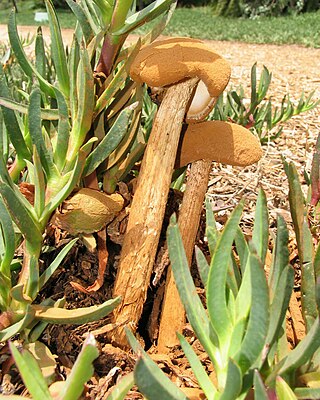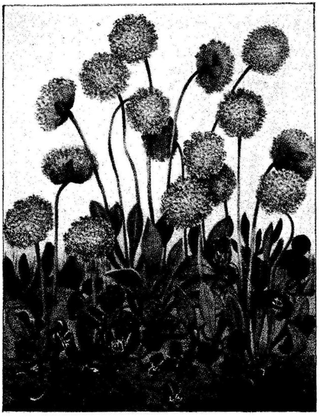
Alexander Segger George is an Australian botanist. He is an authority on the plant genera Banksia and Dryandra. The "bizarre" Restionaceae genus Alexgeorgea was named in his honour in 1976.

Nancy Tyson Burbidge was an Australian systemic botanist, conservationist and herbarium curator.

The Fungi of Australia form an enormous and phenomenally diverse group, a huge range of freshwater, marine and terrestrial habitats with many ecological roles, for example as saprobes, parasites and mutualistic symbionts of algae, animals and plants, and as agents of biodeterioration. Where plants produce, and animals consume, the fungi recycle, and as such they ensure the sustainability of ecosystems.
Alec E. Wood was a mycologist affiliated with the University of New South Wales in Sydney, Australia who published major studies, describing a large number of new species, in the genera Galerina and Amanita. With Tom May, he co-authored Fungi of Australia Volume 2A, Catalogue and Bibliography of Australian Macrofungi - Basidiomycota in 1997.

Omphalotus nidiformis, or ghost fungus, is a gilled basidiomycete mushroom most notable for its bioluminescent properties. It is known to be found primarily in southern Australia and Tasmania, but was reported from India in 2012 and 2018. The fan or funnel shaped fruit bodies are up to 30 cm (12 in) across, with cream-coloured caps overlain with shades of orange, brown, purple, or bluish-black. The white or cream gills run down the length of the stipe, which is up to 8 cm (3 in) long and tapers in thickness to the base. The fungus is both saprotrophic and parasitic, and its fruit bodies are generally found growing in overlapping clusters on a wide variety of dead or dying trees.

The National Herbarium of Victoria is one of Australia's earliest herbaria and the oldest scientific institution in Victoria. Its 1.5 million specimens of preserved plants, fungi and algae—collectively known as the State Botanical Collection of Victoria—comprise the largest herbarium collection in Australia and Oceania.

Porpolomopsis lewelliniae, commonly known as the mauve splitting wax-cap, is a gilled fungus of the waxcap family found in wet forests of eastern Australia and New Zealand. The small mauve- or lilac-coloured mushrooms are fairly common and appear in moss or leaf litter on the forest floor in autumn, and are biotrophic. The key distinguishing feature is the splitting of the cap dividing down the middle of the individual gills.

Battarrea phalloides is an inedible species of mushroom in the family Agaricaceae, and the type species of the genus Battarrea. Known in the vernacular as the scaley-stalked puffball, sandy stiltball, or desert stalked puffball, it has a woody, slender, and shaggy or scaly stem that is typically up to 40 centimeters (15.7 in) in length. Although its general appearance resembles an agaric with stem and gills, atop the stem is a spore sac, consisting of a peridium and a powdery internal gleba. In maturity, the spore sac ruptures to release the spores. Battarrea phalloides is found in dry, sandy locations throughout the world, and has been collected from Africa, Asia, Australia, Europe, North America, and South America. There is currently some disagreement in the literature as to whether the European B. stevensii is the same species as B. phalloides.

Echinostelium is a genus of slime mould, and the only genus in the monotypic family Echinosteliaceae, or Echinosteliidae. It was discovered by Heinrich Anton de Bary in 1855, apparently near Frankfurt am Main. Some species of Echinostelium have a sexual life cycle; others have been shown to be asexual. The plasmodium can divide vegetatively, in a process called plasmotomy, to distinguish it from true cell division.
Derek Agutter Reid was an English mycologist.
Muelleria is a peer-reviewed scientific journal on botany published by the Royal Botanic Gardens Melbourne. It focuses on topics relating to plants, algae, and fungi in the southern hemisphere and Australia in particular. The journal was named in honour of Victorian Government botanist Ferdinand von Mueller. Muelleria commenced publication in 1955 with funding from the Maud Gibson Trust. The trust was initiated in 1945 following the donation of £20,000 by Maud Gibson, a daughter of William Gibson, founder of the Foy & Gibson department store chain.

Colus hirudinosus is a species of stinkhorn fungus (Gasteromycete) found in Asia, Australia, northern Africa, and southern Europe. The fruit body has a short, thick stalk that divides into several spongy, wrinkled, stalk-like, orange to red columns that are united at the top, thus forming a lattice. The spores are found within the gleba—a dark, olive-brown slime that coats the inside of the columns. Spores are spread by insects that are attracted by the fetid smell of the gleba, eat the spores, and pass them on to germinate elsewhere.

Ramaria fennica, commonly known as the bitter coral, is a coral mushroom in the family Gomphaceae. It is found in Australia, Europe and North America.
Hygrocybe kula is a mushroom of the waxcap genus Hygrocybe found only in Royal National Park and Lane Cove Bushland Park. It was described in 1997 by mycologist Cheryl Grgurinovic.
Roy Watling, PhD., DSc, FRSE, F.I.Biol., C.Biol., FLS is a Scottish mycologist who has made significant contributions to the study of fungi both in the identification of new species and correct taxonomic placement, as well as in fungal ecology.
Dr Teresa Lebel is a taxonomist and ecologist who works on fungi, with a particular interest in subterranean truffle-like fungi and their mushroom, bolete, bracket or cup relatives.
Donald Bruce Foreman was an Australian botanist who worked on the Monimiaceae and Proteaceae of Australia. He also helped with the editing of selected Flora of Victoria and Flora of Australia Volumes.
Josephine (Pina) Milne is an Australian bryologist, and former Manager Collections at the National Herbarium of Victoria at the Royal Botanic Gardens Victoria.

Malcolm Ian Howie (1900–1936) was a self-taught commercial and botanical watercolour artist and Methodist local preacher.
Genevieve M. Gates is an Australian mycologist, ecologist, and taxonomist who is particularly focused on the fungal diversity of Tasmania.










